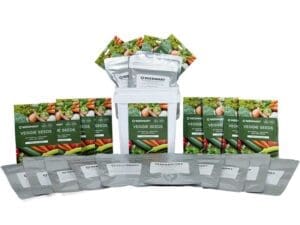RHUBARB ‘Victoria’ Vegetable Seeds
Botanical Name: Rheum rhabarbarum
‘Victoria’ is an old-fashioned, reliable rhubarb variety known for its long, tender, deep red stalks that fade to green at the base. It produces large, flavourful stems with a balanced tart-sweet taste and is one of the easiest rhubarb varieties for home gardeners. A vigorous, heavy-yielding perennial. NB: Do not eat leaves as they are toxic.
Plant Type: Perennial vegetable; very hardy and cold-tolerant
Plant Height: 60 – 90 cm
Sow When:
- Temperate Subtropical: Late winter to early spring; can also be sown in autumn in mild areas
- Tropical: Not recommended—rhubarb prefers cooler climates
- Cool: Late winter through spring
- Arid Climates: Early spring; ensure consistent moisture during establishment
Germination:
- 14 – 21 days
- Depth: 5 mm deep
- Temperature: 15–20°C
Position: Full sun to partial shade (prefers cooler summers)
Sow Where: Sow in trays or small pots and transplant once strong; or direct sow in cool climates
Soil Type: Rich, moist, well-drained soil with plenty of organic matter; pH 6.0 – 6.8
Rows: 90 cm apart
Spacing: 60 – 100 cm between plants (rhubarb grows large)
Details: Rhubarb is a long-lived perennial that prefers cool conditions. Keep soil consistently moist during establishment and mulch well to retain moisture. Remove flower stalks to encourage leaf and stem growth. Do not harvest in the first year—allow plants to establish a strong crown.
Harvest: Harvest in the second year once stalks are thick and well-coloured. Pull stalks from the base with a gentle twist rather than cutting. Avoid harvesting more than one-third of the plant at once. Leaves are toxic and should not be eaten.
Growing Tips
| Tip | Details |
|---|---|
| Choose a cool microclimate | Plant in morning sun and afternoon shade. Avoid harsh western sun in SEQ. |
| Add organic matter | Rhubarb is a heavy feeder—mix compost, manure, and worm castings into soil. |
| Mulch heavily | Use thick mulch to keep soil cool, retain moisture, and protect roots in summer. |
| Water consistently | Deep watering 2–3 times per week prevents thin, stressed stalks in warm climates. |
| Improve airflow | Humidity in SEQ increases fungal risk. Space plants well and avoid overhead watering. |
| Expect a summer slowdown | Growth may pause during peak heat. Keep soil moist and mulched—plants rebound later. |
| Feed in autumn | Apply slow-release organic fertiliser to strengthen crowns before winter–spring growth. |
| Harvest lightly | Warm climates stress plants—take only a few stalks at a time to maintain vigour. |
| Remove flower stalks | Hot weather may cause bolting. Remove flower stems early to promote leaf and stalk growth. |



